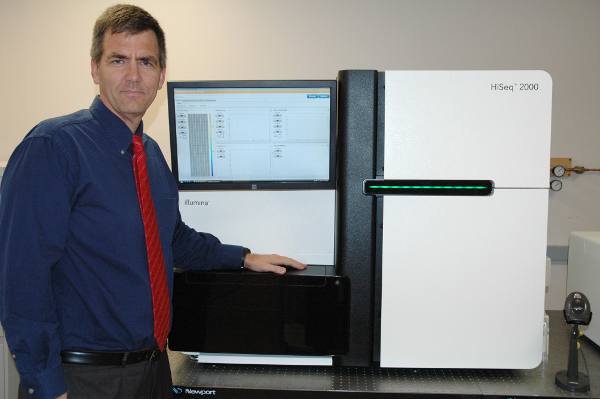June 14, 2012

Discoveries unfathomable only a few years ago are reality today at the Texas AgriLife Genomics and Bioinformatics Service with the acquisition of next-generation sequencing technology on the Texas A&M University campus in College Station, said the director of the service.
“As we move into the genome-sequencing era, we are entering a truly amazing period in history,” said Dr. Charles Johnson, director of the service. “Our mission is to facilitate scientific discoveries by guiding and empowering scientists across the Texas A&M University System over an increasingly complex and technologically advanced terrain.”
The genomics and bioinformatics service was established in the fall of 2010, but it is the recent purchase of the Illumina HiSeq 2500 next-generation sequencing system that will give the team led by Johnson the capability to make a huge impact on crop breeding.
“Although focused on plant breeding, this machine has the potential to sequence the equivalent of the human genome in one day for as little as $1, 000,” Johnson said. “It took more than 13 years to do the original human genome project, and cost $2.7 billion.
“We can also mix large numbers of samples within one lane using sequencing-based bar codingto provide cheaper per-sample pricing,” he said, “which in turn leads to larger studies and greater scientific discoveries.”
One of the keys to this technology is bioinformatics analysis, or analyzing the tidal wave of data and turning it into usable information, Johnson said. AgriLife has invested significant resources in this area as well.
He compared it to a giant puzzle, and the team of bioinformaticians, geneticists, statisticians, mathematicians and computer scientists are the ones who put the DNA information pieces together to make the complete picture.
Dr. Bill McCutchen, AgriLife Research executive associate director, said this genomics capability will be of particular importance to the wheat breeding program.
“This provides our scientists with the capability to quickly advance important traits that we find in our multiple research plots across Texas, traits such as drought tolerance,” McCutchen said. “The molecular-marker system provides a genetic road map of sorts, and we can now advance our breeding and agronomic research programs at a much faster pace.”
Johnson said AgriLife scientists are now able to connect the genetic information from large numbers of breeding populations to a wealth of phenotypic information, making the connection between genes and resistance to drought, disease and insects, as well as other high-value traits leading to increased yields over a broad range of conditions.
Instead of looking at one or two markers at a time, “we can look at hundreds of thousands of markers at one time,” he said.
“We now have the ability with genomics to integrate and develop superior wheat varieties for yield, drought tolerance, quality and other traits in a much shorter period of time as compared to conventional means of breeding,” McCutchen said. “By combining our strong breeding, pest management and agronomic expertise with genetic knowledge, we, AgriLife, are able to produce significant advancements across cropping systems.”
Both McCutchen and Johnson said this technology applies to all crops, livestock, diseases and human health – anything with DNA.
“AgriLife Research, in a visionary effort, has launched this center and made it available to the entire Texas A&M University System,” Johnson said. “We are not a for-profit center, but it takes a significant amount of money to keep the doors open.
“Our goal is to provide the best possible sequencing and bioinformatics service for all our collaborators, and through that effort, provide the greatest possible return to the citizens of Texas and the world by way of revolutionary new discoveries.”
You May Also Like




